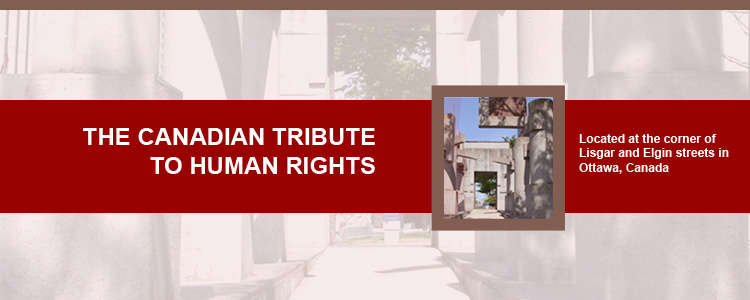
|
|
|
|
|
|
|
|
 |
|||||||||||||
|
|||||||||||||

|
Before the UnveilingEach generation defines human rights in its own social and political context. Perhaps a volunteer’s
definition captures the spirit infusing the Canadian Tribute to Human Rights: In 1989 and 1990, all of us were stirred as the citizens of Central Europe, the peoples of the U.S.S.R., black South Africans and others fought for freedom. While each breakthrough is dramatic, years of effort and endurance laid the foundation for these victories. Struggles elsewhere both touch us here in Canada and challenge us to offer solidarity. Nothing of value comes easily. Likewise, the project of the Canadian Tribute to Human Rights started in 1983 with the vision of a few, that eventually involved hundreds of supporters who believe our country needs a tangible reminder that human rights affect our daily lives, our sense of dignity, and often our survival. As news of the solidarity trade union struggle in Poland spread around the world in 1980/81, people all over Canada supported the attempts of Polish society to transform a totalitarian regime by non-violent means. The imposition of martial law failed to break a growing social movement founded on respect for human rights. In 1983, members of the Canadian Polish Congress launched a project to commemorate the determined struggle for human rights in Poland. Lech Walesa’s letter that year to Hania Fedorowicz, a project founder, underscored this vision and the universality of human rights. In the space of less than a decade, the Polish example was followed by a chain-reaction of events which have transformed the political order of Europe and laid the foundation for an end to the Cold War. Drawing on this inspiration, a group of Canadians joined together on Dec. 10, 1983 - International Human Rights day - to create a permanent artistic symbol of the historic and ongoing struggles of ordinary women, men and children everywhere for fundamental human rights. Seven months later they formed the Canadian Tribute to Human Rights Inc., a community-based, charitable organization. A volunteer board of directors was assisted by a small staff, and supported by 36 patrons and nearly 400
national and local groups from all sectors of Canadian society, in addition to all levels of government
and numerous companies. “And now, that rarest of entities - a sculptural commission that made sense from the outset, was conducted with fairness to all concerned, and produced indisputably fine results.” One hundred and twenty-nine artists and architects from across Canada entered the competition. André Fortier, past president of the Social Sciences and Humanities Research Council of Canada and a former director of the Canada Council, chaired the jury of eminent Canadians from all regions of the country. The members were Sheila Butler, artist and professor at the University of Winnipeg; Phyllis Lambert, architectural historian and director of the Canadian Centre for Architecture; Suzanne Rivard-LeMoyne, artist and professor at the University of Ottawa; Mary Pratt, artist, St. Mary’s Bay, Newfoundland; Larry Richards, architect and director of the School of Architecture, University of Waterloo; Jack Shadbolt, artist and teacher at the Vancouver School of Art; and Pierre Thébèrge, then curator and director of the Montreal Museum of Fine Arts. The following 10 finalists were selected in February 1986: Baird/Sampson, architects, Toronto; Melvin Charney, artist/architect, Montreal; Stephen Cruise, artist, Willowdale; Max Dean and Associates, artists/designers, Ottawa, Winnipeg and Vancouver; Michel Goulet, artist, Toronto; Claude Toussignant, artist, Montreal; Irene Whittome, artist, Montreal; Janalee Hassan, artist, London; Al McWilliams, artist, Vancouver; Judith Schwarz, artist, Toronto. Each finalist received a $5,000 honorarium to complete a proposed design with a scale model by August 31, 1986. In September 1986, the jury unanimously selected the entry of Melvin Charney, awarding him the $10,000 prize for an impressive sculpture which narrates the struggle for human rights in granite and concrete. The jury noted the dignity and permanence of the design, its integration with buildings adjacent to the site, and commended Charney for his rich use of symbols conveying many levels of meaning. Later the design received the unanimous approval of the council of the then Regional Municipality of Ottawa-Carleton, which donated the land. The construction fund drive was launched on April 13, 1988 and within five months the project opened a walk-in office, made available by the National Capital Commission. The ground for the monument was ceremoniously broken in November 1988 and the following month the
Canadian Tribute to Human Rights marked the 40th anniversary of the Universal Declaration of Human
Rights. Construction began in July 1989. On December 19, 1989, Edward Broadbent, then president of the International Centre for Human Rights and
Democratic Development in Montreal, was the first person to sign a condolence book at the Tribute site
honouring Nobel Peace Prize winner Andrei Sakharov, a founding member of the Moscow Human Rights
Committee. The book, signed by hundreds of Canadians, was forwarded to Sakharov’s widow Yelena
Bonner. It was a moving event, in part because the group had chosen the snow-covered base of the still-to-be-finished Tribute as the site to express its deep concern; the Tribute had started to become the public forum for which it was designed, a rallying point for efforts to create a more just and humane world. |
   
|
|
|